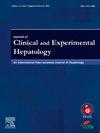Long-Term Survival and Recurrence in HCC vs. Non-HCC Liver Transplant Recipients: A Two-Decade Longitudinal Analysis
IF 3.3
Q2 GASTROENTEROLOGY & HEPATOLOGY
Journal of Clinical and Experimental Hepatology
Pub Date : 2024-12-16
DOI:10.1016/j.jceh.2024.102489
引用次数: 0
Abstract
Background
We aim to compare the long-term survival outcomes of patients who have received liver transplants (LTs) as a result of primary hepatocellular carcinoma (HCC).
Methods and materials
A retrospective registry analysis of the Scientific Registry of Transplant Recipients (SRTR) database was done for LTs that were performed in the United States from January 2000 to June 2023.
Results
A total of 143,717 LT cases have met both the inclusion and the exclusion criteria and were included in the final analysis. The most common primary diagnosis in the non-HCC cohort was hepatitis C virus (HCV) (14,813 cases, 27%), alcoholic cirrhosis (6631 cases, 12.1%) in the 2001–2010 cohort, alcoholic cirrhosis (18,370 cases, 20.7%), and non-alcoholic steatohepatitis (NASH) (13,997 cases,15.8%) in the 2011–2023 cohort. The data analysis showed a significant overall one- and five-year allograft survival improvement in the 2011–2023 time frame compared to the 2001–2010 group in both HCC and non-HCC patients. The allograft survival difference became more significant after the 5 years of follow-up with a 10% difference between the two time frames in both HCC and non-HCC groups. Patients who met and were selected based on Milan's criteria had significantly better outcomes in both cohorts. Five-year allograft and patient survival were also significantly higher in the patients who met Milan's criteria in 2011–2023 cohort, compared to 2001–2010 cohort (74.4% vs. 66.1%, P-value <0.001, and 76% vs. 68.7%, P-value <0.01, respectively). Acute and chronic rejections were significantly higher in the non-HCC groups in both time frames. It was 6.5% vs. 4.8%, P = 0.03 in 2001–2010, and 13.6% vs. 8.2%, P = 0.0007 in 2011–2023, for acute rejection and 10.8% vs. 6.7%, P = 0.0001 in 2001–2010, and 14.1% vs. 10.3%, P = 0.01 in 2011–2023, for chronic rejection.
Conclusion
Short- and long-term outcomes of LT are almost equal to the other causes of liver transplantation in the recent decade, which can significantly overcome the dilemma of doing LT in patients with HCC diagnosis, who need LT. Adhering to the Milan criteria is crucial for optimizing outcomes, as demonstrated by our study's findings, which highlight significantly better allograft and patient survival rates among those who meet these criteria.
HCC与非HCC肝移植受者的长期生存和复发:一项20年的纵向分析
背景:我们的目的是比较原发性肝细胞癌(HCC)患者接受肝移植(LTs)的长期生存结果。方法和材料对2000年1月至2023年6月在美国进行的移植受者科学登记(SRTR)数据库进行回顾性登记分析。结果143,717例LT符合纳入标准和排除标准,纳入最终分析。非hcc队列中最常见的原发性诊断为丙型肝炎病毒(HCV)(14813例,27%),2001-2010年队列中酒精性肝硬化(6631例,12.1%),2011-2023年队列中酒精性肝硬化(18370例,20.7%)和非酒精性脂肪性肝炎(NASH)(13997例,15.8%)。数据分析显示,与2001-2010年组相比,2011-2023年期间,HCC和非HCC患者的1年和5年同种异体移植生存率均有显著提高。同种异体移植物的生存差异在5年随访后变得更加显著,HCC组和非HCC组在两个时间框架之间的差异为10%。在两个队列中,符合并根据米兰标准选择的患者都有明显更好的结果。2011-2023年队列中符合米兰标准的患者的5年同种异体移植和患者生存率也显著高于2001-2010年队列(分别为74.4%对66.1%,p值<;0.001和76%对68.7%,p值<;0.01)。在两个时间段内,非hcc组的急性和慢性排斥反应明显更高。2001-2010年为6.5%对4.8%,P = 0.03; 2011-2023年为13.6%对8.2%,P = 0.0007; 2001-2010年为10.8%对6.7%,P = 0.0001; 2011-2023年为14.1%对10.3%,P = 0.01。结论近十年来,肝移植的短期和长期结果与其他肝移植原因几乎相同,这可以显著克服HCC诊断需要肝移植的患者进行肝移植的困境。坚持米兰标准对于优化结果至关重要,正如我们的研究结果所表明的那样,符合这些标准的患者的同种异体移植和患者生存率显著提高。
本文章由计算机程序翻译,如有差异,请以英文原文为准。
求助全文
约1分钟内获得全文
求助全文
来源期刊

Journal of Clinical and Experimental Hepatology
GASTROENTEROLOGY & HEPATOLOGY-
CiteScore
4.90
自引率
16.70%
发文量
537
审稿时长
64 days
 求助内容:
求助内容: 应助结果提醒方式:
应助结果提醒方式:


